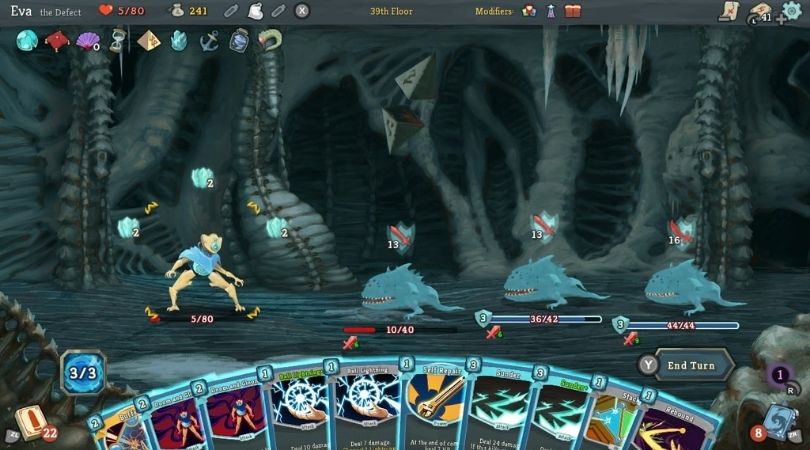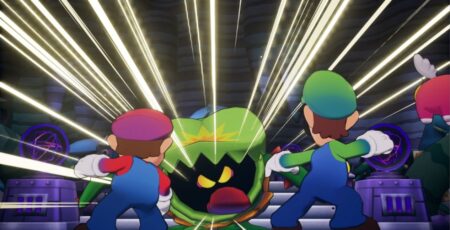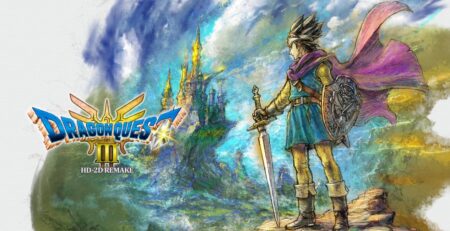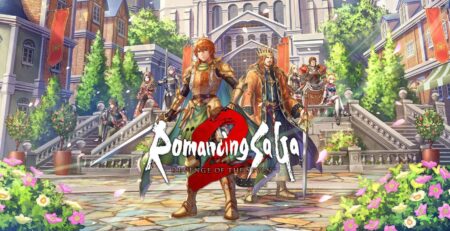
Slay the Spire is a roguelike, deck-building strategy game developed by Mega Crit and published by Humble Bundle earlier in 2019 on Nintendo Switch, PC, Mac, Linux, and PS4. Your goal is simple—slay the spire. In other words, you must make your way to the highest floor of the dungeon by amassing a powerful deck of cards.
In Slay the Spire, you can play as either the Ironclad, the Silent, or the Defect. Each is a distinct character with its own abilities and strengths. Once picking a character, you choose which path you’d like to start with and begin building your way up to higher floors, mostly by killing enemies.
After defeating a monster, you pick between three different cards to add to your deck. This is how you get stronger and how you start to build a unique strategy based on your own playstyle and preferences. While climbing the spire, you also encounter random events, chests, and a merchant who sells you cards and artifacts. Artifacts are essentially items that you collect, normally after defeating bosses, that give you permanent bonuses for the rest of your run.
In addition to the characters, there are three game modes on the Switch version—Standard, Daily Climb, and Custom. In Standard, you pick your character, build your deck, and slay the spire without any added complications. Daily Climb mode is more of a challenge. A new one starts every 24 hours and your character is assigned to you, as well as different stipulations. For example, one time I played I received artifacts instead of cards after defeating regular monsters, which made it harder to create a thorough, strong deck. Custom is exactly what it sounds like and there are tons of options you can tweak to create and personalize your run.
When you’re in combat, the Slay the Spire functions similarly to most trading card games. Each card costs energy to use. You start with three energy, although some cards can give you more throughout the fight. Once you play the card, it does whatever the action on the card lists and then you put it in your discard pile. After you run out of cards, your discard pile gets reshuffled so you can draw from it again. You have to think carefully about what cards you choose to play, however. Any card that you don’t use by the end of your turn also gets discarded, so there’s not much you can do to plan ahead for the next round.
The basic actions are to either attack or defend, but some cards cause status effects, like poison, while others boost your stats or weaken your enemies’ stats. Other cards, once played, stick around for the rest of combat. These cards have varying effects. My favorites automatically gave me defense after I finished my turn and added an extra energy that I could use throughout the fight. Much like the rest of the game, there are so many of these permanent cards that switching up your strategy and tailoring it to your playstyle is fun and relatively easy once you figure out how the game works.
In general, the freedom to pick how I wanted to play, even though whatever character or mode I chose added different challenges, made the game an awesome experience. My favorite character, and the one that I was the best with, was the Defect whose mechanic revolves around a magical orb system. Your cards can either trigger your orbs’ active effect, causing it to disappear afterward, or you can just let the orbs hang around and use their passive effect at the end of each turn.
Lightning, for example, causes eight damage to a random enemy if it’s activated. Most of the time, though, I just left my lightning channeled so it would use its passive effect, which caused three damage to a random enemy at the end of each turn. I would amass as many lightning orbs as possible so I could automatically deal a decent amount of damage every round. With the number of orb types available, each with different abilities, I was able to tailor and adapt my strategy depending on what monsters I was fighting that run, which was a cool customizable factor on top of the deck mechanic.

Additionally, while the enemies did get challenging, the randomness of the spire and my deck of cards never felt unfair or frustrating. In fact, dying never felt like a punishment. Instead, it motivated me to try again with whatever new knowledge or strategy I had come up with. Plus, in Standard, you unlock new cards that might appear in your next run when you repeatedly play as the same character. I would die, unlock new and interesting cards, and immediately dive back in to see if I would get lucky enough with my randomized fresh deck to come up with an effective strategy.
The Daily Climb was also extremely fun, even though I was pretty terrible at it most of the time. I loved the test of being forced to use a particular character, often with weird stipulations on cards or rewards. It was difficult but in a fun way and looking at the leaderboards and seeing how incredible other people were at the game was a great way to incorporate the flourishing online community and fanbase.
While there wasn’t a story mode to conquer, the game did give you something to complete: a compendium, including a percentage, of all relics and cards you’ve encountered throughout your runs. I loved this because it gave me something to aim for in addition to climbing the floors. Not only was there a challenge of advancing in combat, but there was a collection aspect to encourage you to play over and over again.
Overall, I loved Slay the Spire and it definitely deserves the nomination for Fresh Indie Game at the Game Awards, which airs on December 12th. Historically, I’m not a fan of roguelike games, but Slay the Spire made me reconsider my position. While I did occasionally tire of fighting the same monsters all the time, that’s really my only complaint. The combat is smart and can get complicated, but the game makes everything easy to understand and doesn’t feel too punishing, even when it’s difficult. The randomness of the deck-building always felt like a new challenge and made every run exciting. When Standard started to feel stale, I could jump into the Daily Climb to try out something completely different. Other than the broad category of “strategy game,” Slay the Spire didn’t sound like anything that I would normally play. However, it has firmly cemented itself as one of my favorite games of the year and I highly recommend it to anyone interested in roguelikes, cards, or strategy games.
Slay the Spire is available now for Nintendo Switch, PC, Mac, Linux, and PS4.
Slay the Spire
-
Rating - 9/109/10
TL; DR
Overall, I loved Slay the Spire and it definitely deserves the nomination for Fresh Indie Game at the Game Awards, which airs on December 12th. Historically, I’m not a fan of roguelike games, but Slay the Spire made me reconsider my position.





